SMART FORTWO COUPE 2012 Owners Manual
Manufacturer: SMART, Model Year: 2012, Model line: FORTWO COUPE, Model: SMART FORTWO COUPE 2012Pages: 228, PDF Size: 12.76 MB
Page 101 of 228
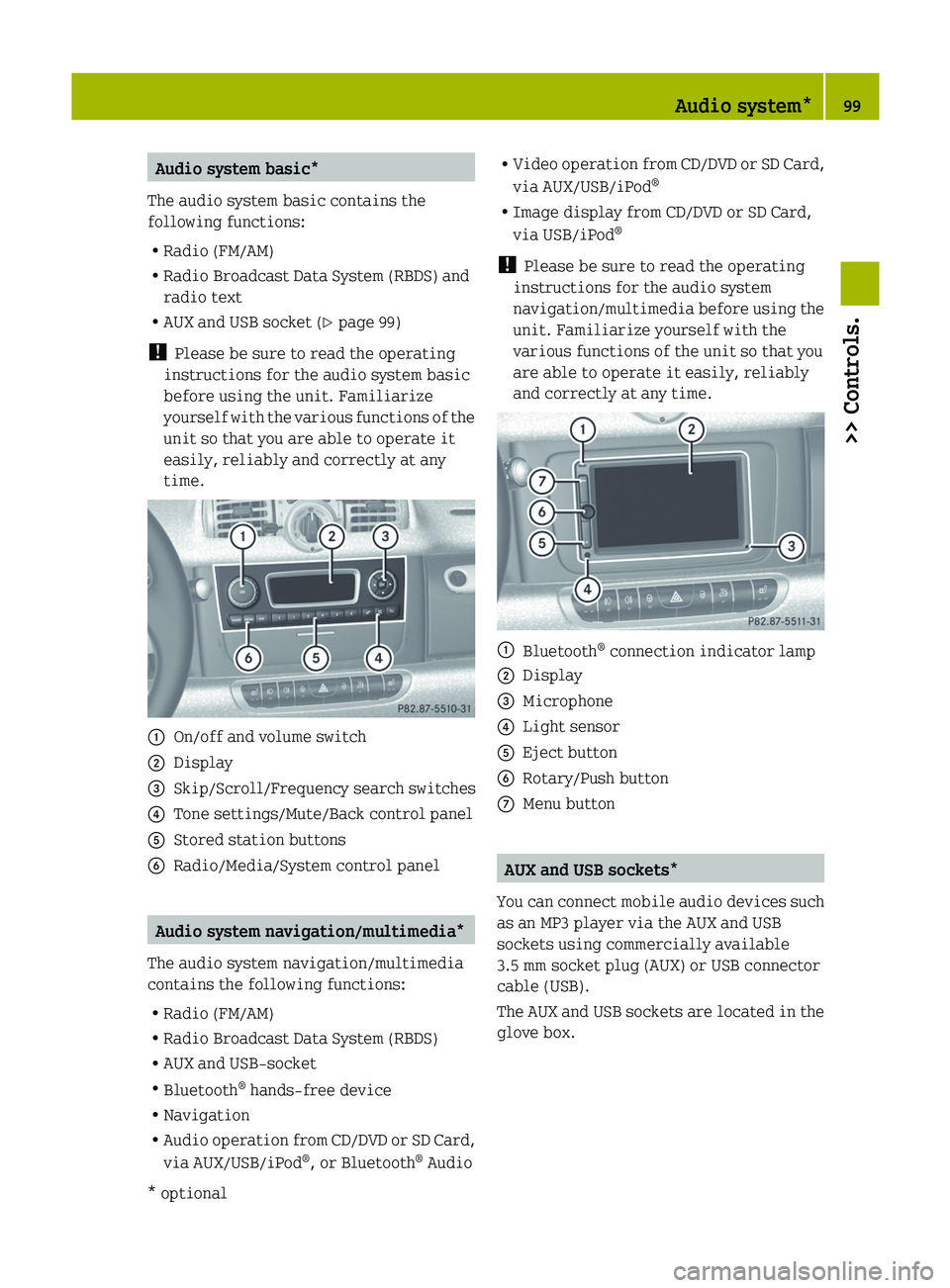
Audio system basic*
The audio system basic contains the
following functions:
R Radio (FM/AM)
R Radio Broadcast Data System (RBDS) and
radio text
R AUX and USB socket ( Y page 99)
! Please be sure to read the operating
instructions for the audio system basic
before using the unit. Familiarize
yourself
with the various functions of the
unit so that you are able to operate it
easily, reliably and correctly at any
time. :
On/off and volume switch
; Display
= Skip/Scroll/Frequency search switches
? Tone settings/Mute/Back control panel
A Stored station buttons
B Radio/Media/System control panel Audio system navigation/multimedia*
The audio system navigation/multimedia
contains the following functions:
R Radio (FM/AM)
R Radio Broadcast Data System (RBDS)
R AUX and USB-socket
R Bluetooth ®
hands-free device
R Navigation
R Audio
operation from CD/DVD or SD Card,
via AUX/USB/iPod ®
, or Bluetooth ®
Audio R
Video
operation from CD/DVD or SD Card,
via AUX/USB/iPod ®
R Image display from CD/DVD or SD Card,
via USB/iPod ®
! Please be sure to read the operating
instructions for the audio system
navigation/multimedia before using the
unit. Familiarize yourself with the
various functions of the unit so that you
are able to operate it easily, reliably
and correctly at any time. :
Bluetooth ®
connection indicator lamp
; Display
= Microphone
? Light sensor
A Eject button
B Rotary/Push button
C Menu button AUX and USB sockets*
You
can connect mobile audio devices such
as an MP3 player via the AUX and USB
sockets using commercially available
3.5 mm socket plug (AUX) or USB connector
cable (USB).
The AUX and USB sockets are located in the
glove box. Audio system*
99
>> Controls.
* optional Z
Page 102 of 228
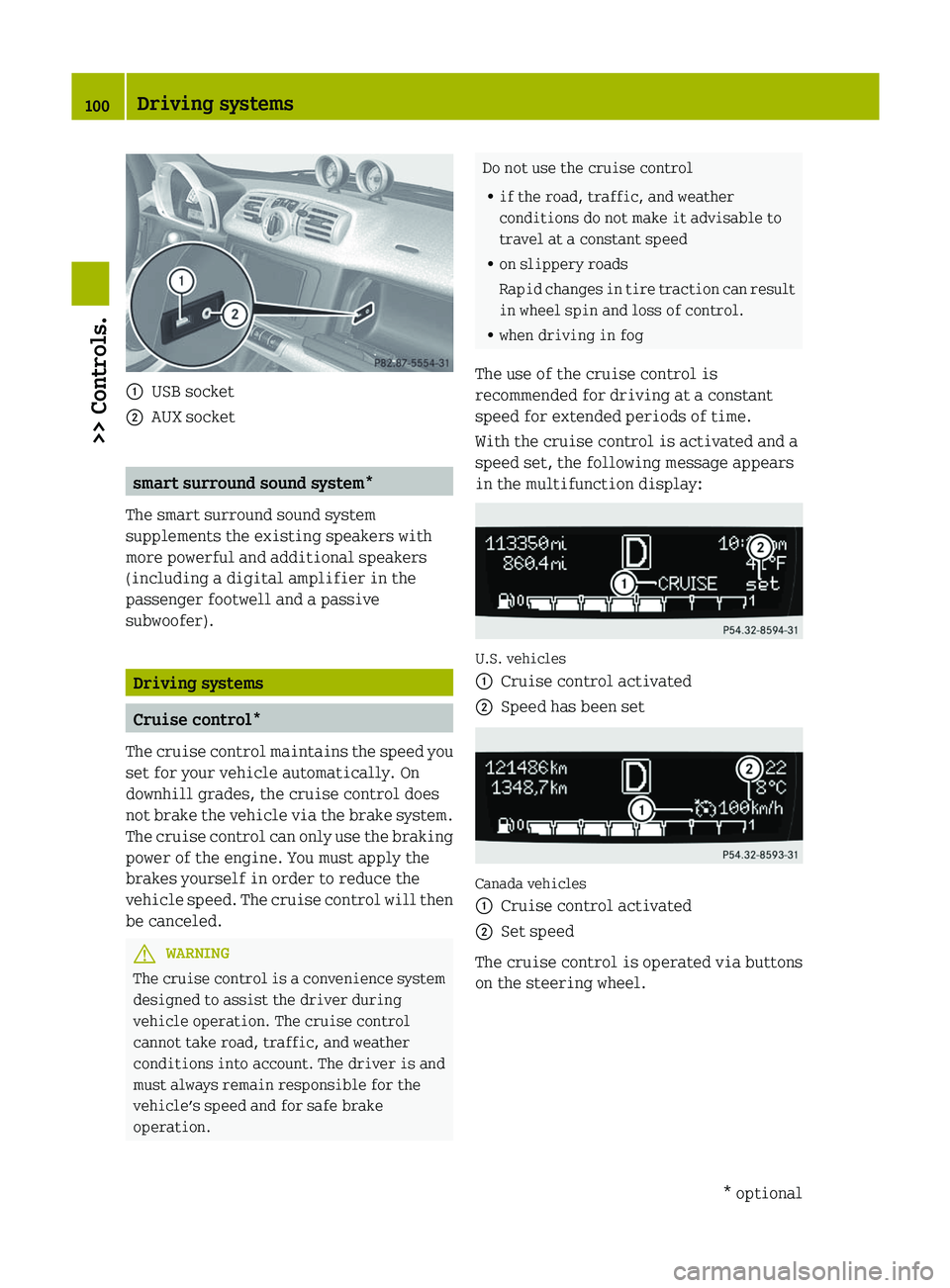
:
USB socket
; AUX socket smart surround sound system*
The smart surround sound system
supplements the existing speakers with
more powerful and additional speakers
(including a digital amplifier in the
passenger footwell and a passive
subwoofer). Driving systems
Cruise control*
The cruise control maintains the speed you
set for your vehicle automatically. On
downhill grades, the cruise control does
not brake the vehicle via the brake system.
The cruise control can only use the braking
power of the engine. You must apply the
brakes yourself in order to reduce the
vehicle speed. The cruise control will then
be canceled. G
WARNING
The cruise control is a convenience system
designed to assist the driver during
vehicle operation. The cruise control
cannot take road, traffic, and weather
conditions into account. The driver is and
must always remain responsible for the
vehicle’s speed and for safe brake
operation. Do not use the cruise control
R
if the road, traffic, and weather
conditions do not make it advisable to
travel at a constant speed
R on slippery roads
Rapid
changes in tire traction can result
in wheel spin and loss of control.
R when driving in fog
The use of the cruise control is
recommended for driving at a constant
speed for extended periods of time.
With the cruise control is activated and a
speed set, the following message appears
in the multifunction display: U.S. vehicles
:
Cruise control activated
; Speed has been set Canada vehicles
:
Cruise control activated
; Set speed
The cruise control is operated via buttons
on the steering wheel. 100
Driving systems
>> Controls.
* optional
Page 103 of 228
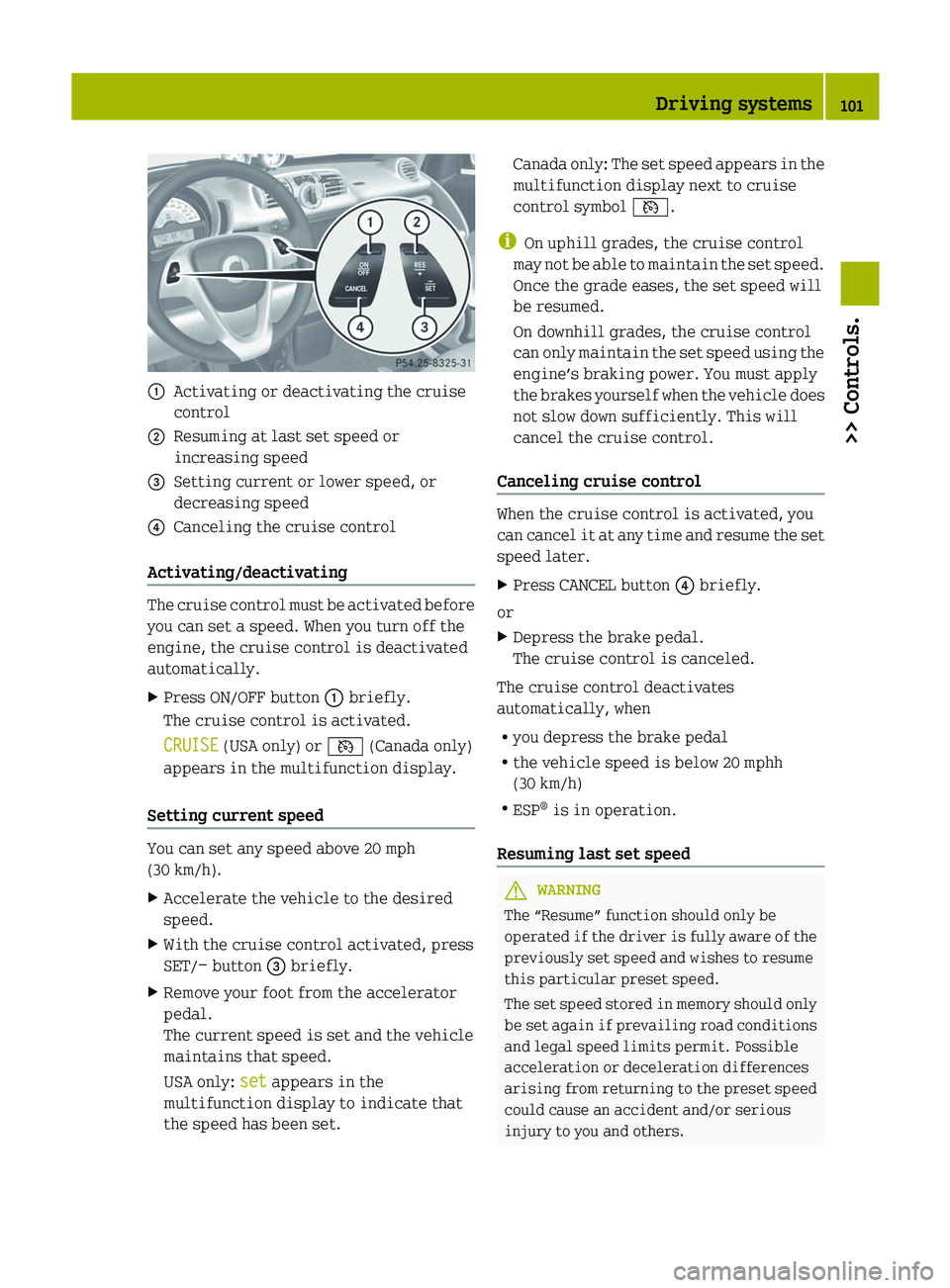
:
Activating or deactivating the cruise
control
; Resuming at last set speed or
increasing speed
= Setting current or lower speed, or
decreasing speed
? Canceling the cruise control
Activating/deactivating The cruise control must be activated before
you can set a speed. When you turn off the
engine, the cruise control is deactivated
automatically.
X
Press ON/OFF button : briefly.
The cruise control is activated.
CRUISE (USA only) or V (Canada only)
appears in the multifunction display.
Setting current speed You can set any speed above 20 mph
(30 km/h).
X
Accelerate the vehicle to the desired
speed.
X With the cruise control activated, press
SET/− button = briefly.
X Remove your foot from the accelerator
pedal.
The current speed is set and the vehicle
maintains that speed.
USA only: set appears in the
multifunction display to indicate that
the speed has been set. Canada only: The set speed appears in the
multifunction display next to cruise
control symbol V.
i On uphill grades, the cruise control
may
not be able to maintain the set speed.
Once the grade eases, the set speed will
be resumed.
On downhill grades, the cruise control
can only maintain the set speed using the
engine’s braking power. You must apply
the brakes yourself when the vehicle does
not slow down sufficiently. This will
cancel the cruise control.
Canceling cruise control When the cruise control is activated, you
can
cancel it at any time and resume the set
speed later.
X Press CANCEL button ? briefly.
or
X Depress the brake pedal.
The cruise control is canceled.
The cruise control deactivates
automatically, when
R you depress the brake pedal
R the vehicle speed is below 20 mphh
(30 km/h)
R ESP ®
is in operation.
Resuming last set speed G
WARNING
The “Resume” function should only be
operated
if the driver is fully aware of the
previously set speed and wishes to resume
this particular preset speed.
The set speed stored in memory should only
be set again if prevailing road conditions
and legal speed limits permit. Possible
acceleration or deceleration differences
arising from returning to the preset speed
could cause an accident and/or serious
injury to you and others. Driving systems
101
>> Controls. Z
Page 104 of 228
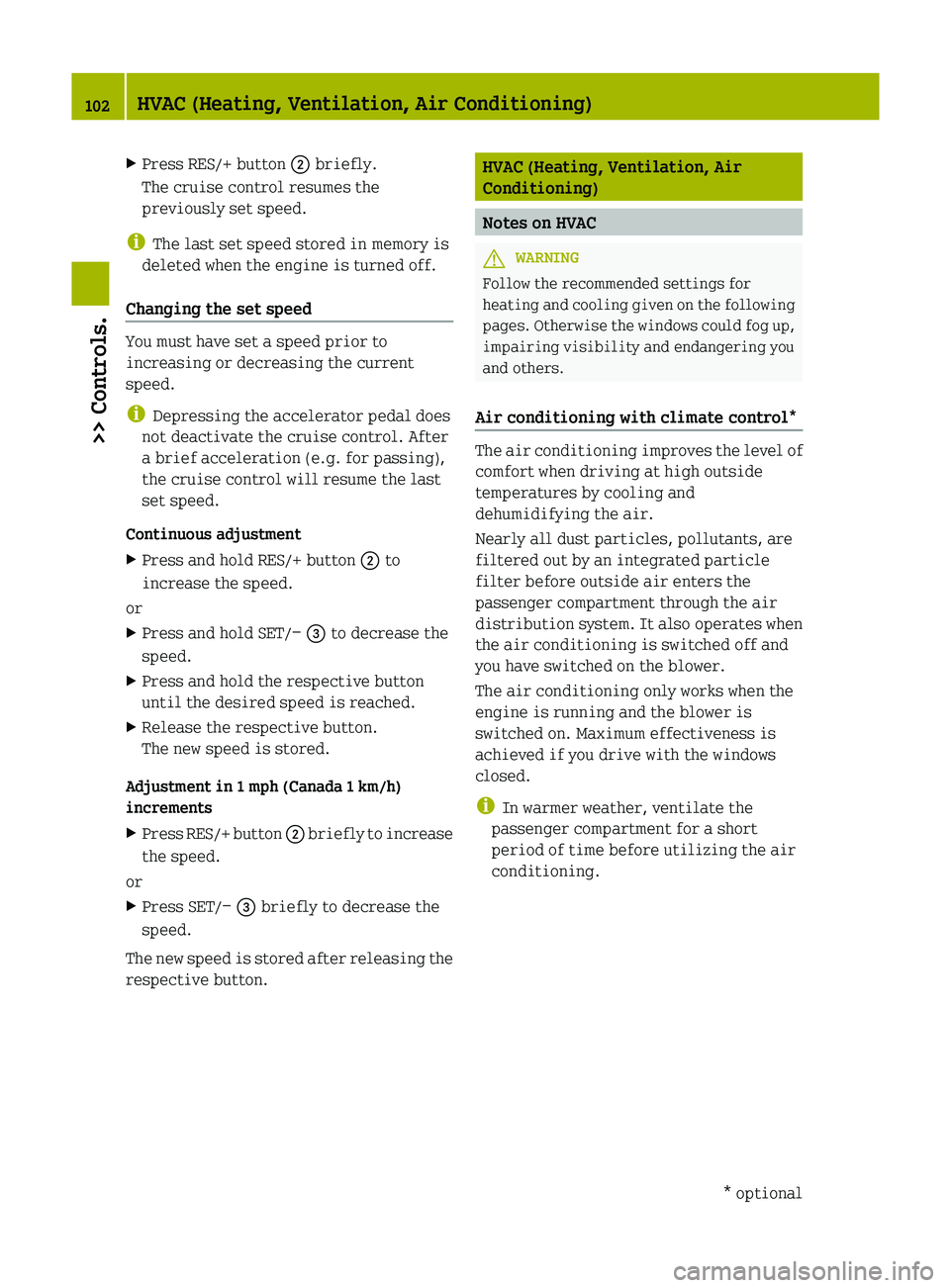
X
Press RES/+ button ; briefly.
The cruise control resumes the
previously set speed.
i The last set speed stored in memory is
deleted when the engine is turned off.
Changing the set speed You must have set a speed prior to
increasing or decreasing the current
speed.
i
Depressing the accelerator pedal does
not deactivate the cruise control. After
a brief acceleration (e.g. for passing),
the cruise control will resume the last
set speed.
Continuous adjustment
X Press and hold RES/+ button ; to
increase the speed.
or
X Press and hold SET/− = to decrease the
speed.
X Press and hold the respective button
until the desired speed is reached.
X Release the respective button.
The new speed is stored.
Adjustment in 1 mph (Canada 1 km/h)
increments
X Press RES/+ button ; briefly to increase
the speed.
or
X Press SET/− = briefly to decrease the
speed.
The new speed is stored after releasing the
respective button. HVAC (Heating, Ventilation, Air
Conditioning)
Notes on HVAC
G
WARNING
Follow the recommended settings for
heating
and cooling given on the following
pages. Otherwise the windows could fog up,
impairing visibility and endangering you
and others.
Air conditioning with climate control* The air conditioning improves the level of
comfort when driving at high outside
temperatures by cooling and
dehumidifying the air.
Nearly all dust particles, pollutants, are
filtered out by an integrated particle
filter before outside air enters the
passenger compartment through the air
distribution
system. It also operates when
the air conditioning is switched off and
you have switched on the blower.
The air conditioning only works when the
engine is running and the blower is
switched on. Maximum effectiveness is
achieved if you drive with the windows
closed.
i In warmer weather, ventilate the
passenger compartment for a short
period of time before utilizing the air
conditioning. 102
HVAC (Heating, Ventilation, Air Conditioning)>> Controls.
* optional
Page 105 of 228
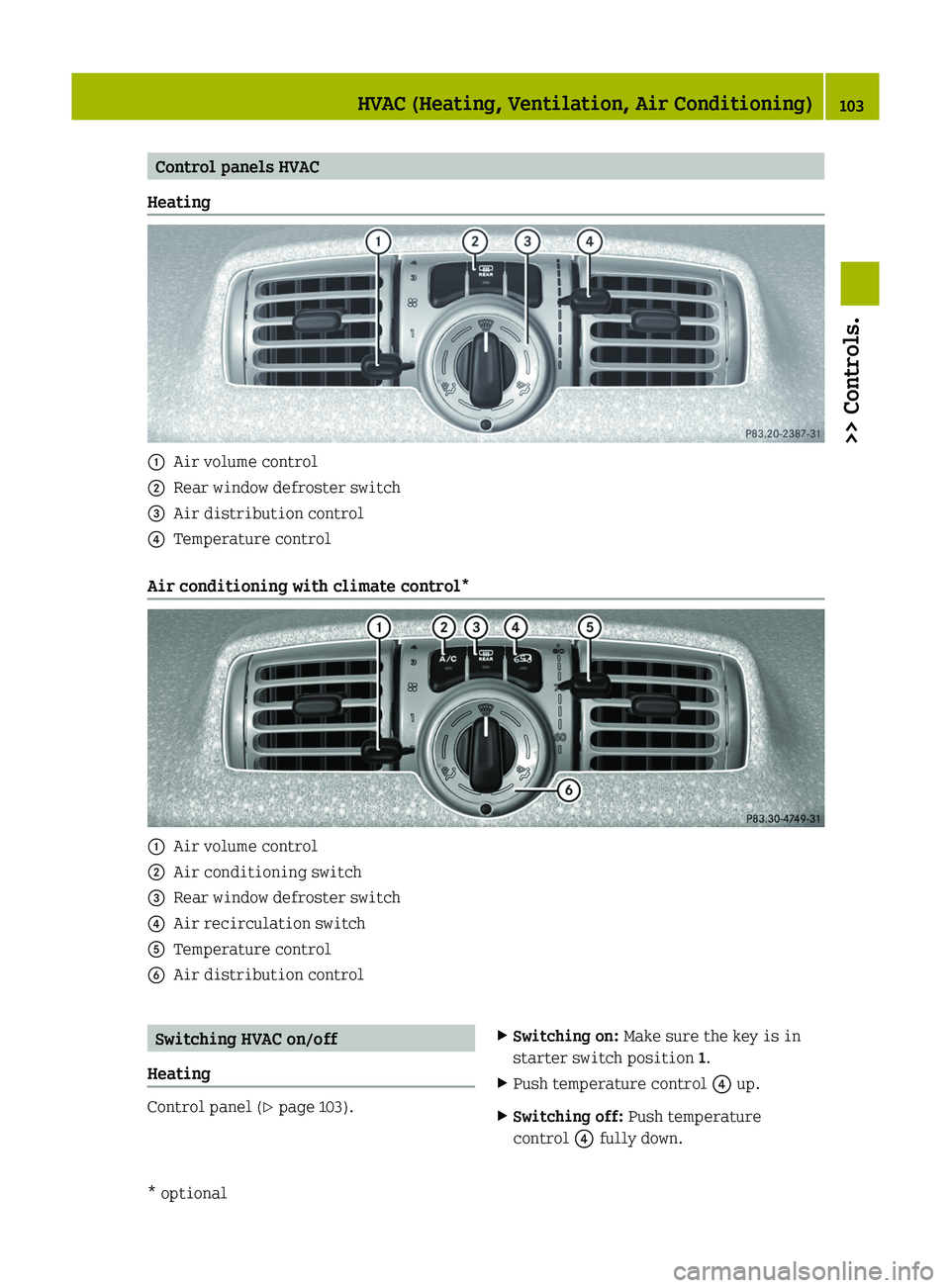
Control panels HVAC
Heating :
Air volume control
; Rear window defroster switch
= Air distribution control
? Temperature control
Air conditioning with climate control* :
Air volume control
; Air conditioning switch
= Rear window defroster switch
? Air recirculation switch
A Temperature control
B Air distribution control Switching HVAC on/off
Heating Control panel (Y page 103).
X
Switching on: Make sure the key is in
starter switch position 1.
X Push temperature control ? up.
X Switching off: Push temperature
control ? fully down. HVAC (Heating, Ventilation, Air Conditioning)
103>> Controls.
* optional Z
Page 106 of 228
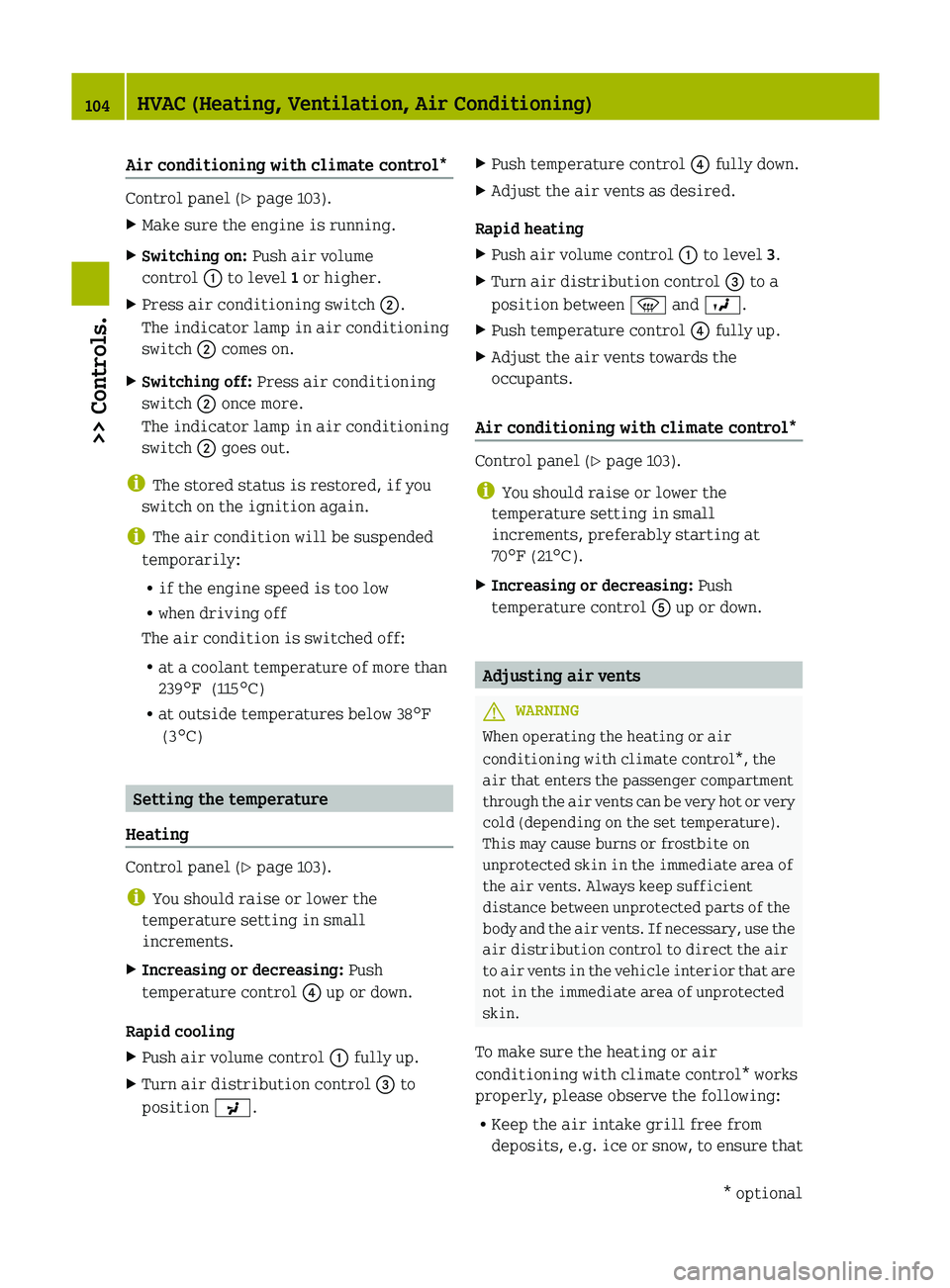
Air conditioning with climate control*
Control panel (Y page 103).
X
Make sure the engine is running.
X Switching on: Push air volume
control : to level 1 or higher.
X Press air conditioning switch ;.
The indicator lamp in air conditioning
switch ; comes on.
X Switching off: Press air conditioning
switch ; once more.
The indicator lamp in air conditioning
switch ; goes out.
i The stored status is restored, if you
switch on the ignition again.
i The air condition will be suspended
temporarily:
R if the engine speed is too low
R when driving off
The air condition is switched off:
R at a coolant temperature of more than
239¦ (115¥)
R at outside temperatures below
38¦
(3¥) Setting the temperature
Heating Control panel (Y page 103).
i
You should raise or lower the
temperature setting in small
increments.
X Increasing or decreasing: Push
temperature control ? up or down.
Rapid cooling
X Push air volume control : fully up.
X Turn air distribution control = to
position P. X
Push temperature control ? fully down.
X Adjust the air vents as desired.
Rapid heating
X Push air volume control : to level 3.
X Turn air distribution control = to a
position between z and O.
X Push temperature control ? fully up.
X Adjust the air vents towards the
occupants.
Air conditioning with climate control* Control panel (Y page 103).
i
You should raise or lower the
temperature setting in small
increments, preferably starting at
70¦ (21¥).
X Increasing or decreasing: Push
temperature control A up or down. Adjusting air vents
G
WARNING
When operating the heating or air
conditioning with climate control*, the
air that enters the passenger compartment
through
the air vents can be very hot or very
cold (depending on the set temperature).
This may cause burns or frostbite on
unprotected skin in the immediate area of
the air vents. Always keep sufficient
distance between unprotected parts of the
body and the air vents. If necessary, use the
air distribution control to direct the air
to air vents in the vehicle interior that are
not in the immediate area of unprotected
skin.
To make sure the heating or air
conditioning with climate control* works
properly, please observe the following:
R Keep the air intake grill free from
deposits, e.g. ice or snow, to ensure that104
HVAC (Heating, Ventilation, Air Conditioning)
>> Controls.
* optional
Page 107 of 228
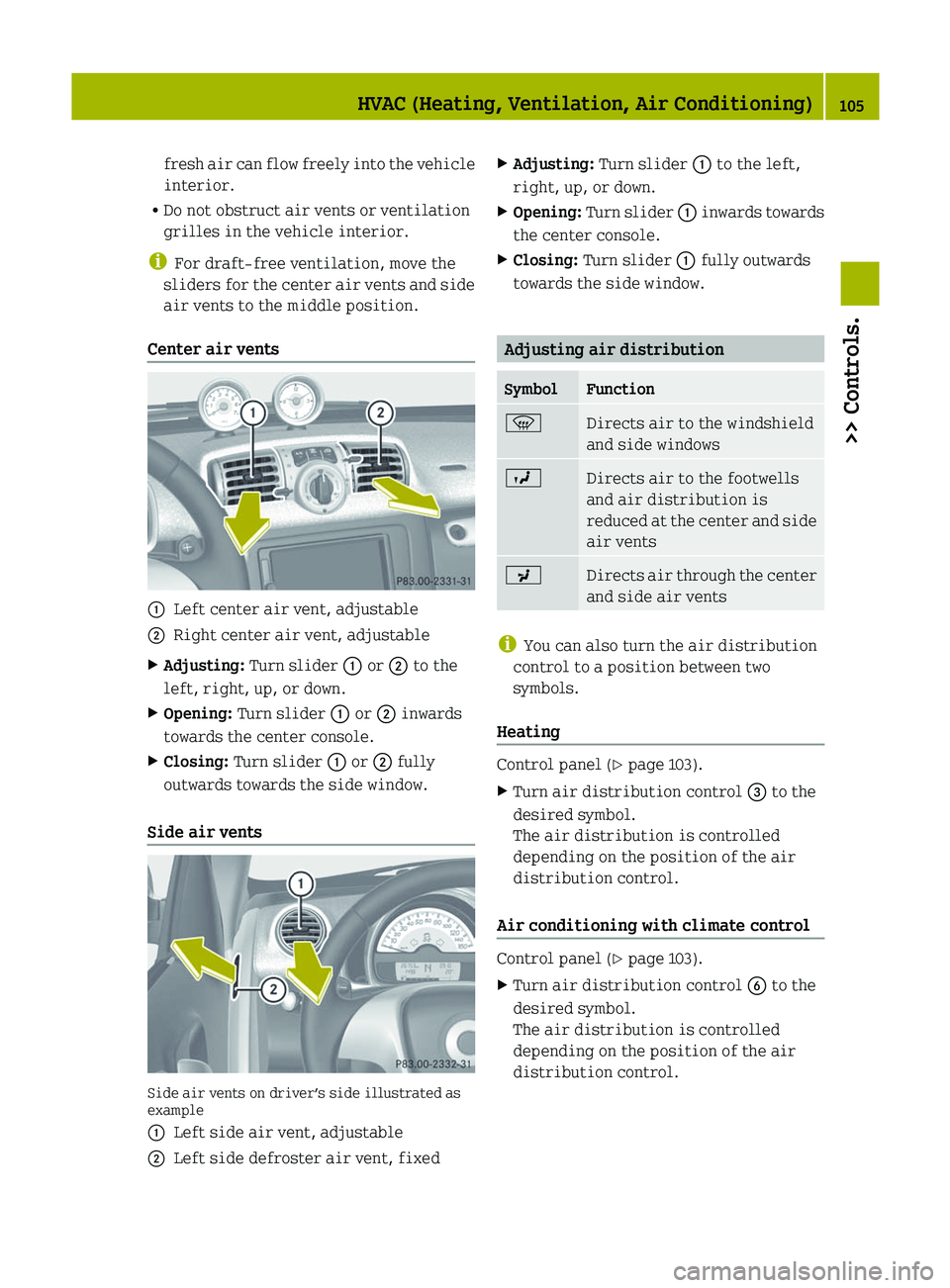
fresh air can flow freely into the vehicle
interior.
R Do not obstruct air vents or ventilation
grilles in the vehicle interior.
i For draft-free ventilation, move the
sliders
for the center air vents and side
air vents to the middle position.
Center air vents :
Left center air vent, adjustable
; Right center air vent, adjustable
X Adjusting: Turn slider : or ; to the
left, right, up, or down.
X Opening: Turn slider : or ; inwards
towards the center console.
X Closing: Turn slider : or ; fully
outwards towards the side window.
Side air vents Side air vents on driver’s side illustrated as
example
:
Left side air vent, adjustable
; Left side defroster air vent, fixed X
Adjusting: Turn slider : to the left,
right, up, or down.
X Opening:
Turn slider : inwards towards
the center console.
X Closing: Turn slider : fully outwards
towards the side window. Adjusting air distribution
Symbol Function
z
Directs air to the windshield
and side windows
O
Directs air to the footwells
and air distribution is
reduced
at the center and side
air vents P
Directs air through the center
and side air vents
i
You can also turn the air distribution
control to a position between two
symbols.
Heating Control panel (Y page 103).
X
Turn air distribution control = to the
desired symbol.
The air distribution is controlled
depending on the position of the air
distribution control.
Air conditioning with climate control Control panel (Y page 103).
X
Turn air distribution control B to the
desired symbol.
The air distribution is controlled
depending on the position of the air
distribution control. HVAC (Heating, Ventilation, Air Conditioning)
105
>> Controls. Z
Page 108 of 228
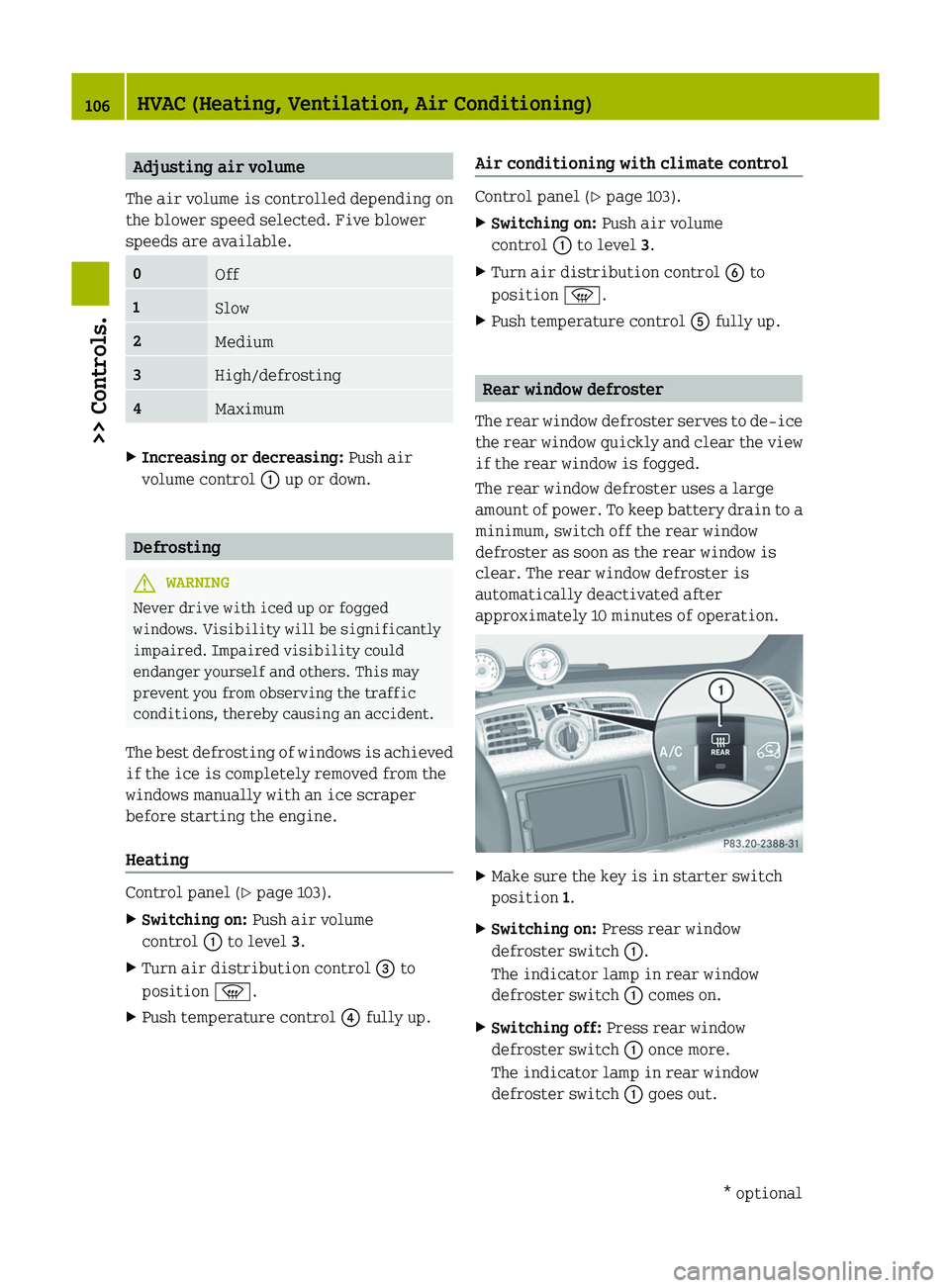
Adjusting air volume
The air volume is controlled depending on
the blower speed selected. Five blower
speeds are available. 0
Off
1
Slow
2
Medium
3
High/defrosting
4
Maximum
X
Increasing or decreasing: Push air
volume control : up or down. Defrosting
G
WARNING
Never drive with iced up or fogged
windows. Visibility will be significantly
impaired. Impaired visibility could
endanger yourself and others. This may
prevent you from observing the traffic
conditions, thereby causing an accident.
The
best defrosting of windows is achieved
if the ice is completely removed from the
windows manually with an ice scraper
before starting the engine.
Heating Control panel (Y page 103).
X
Switching on: Push air volume
control : to level 3.
X Turn air distribution control = to
position z.
X Push temperature control ? fully up.Air conditioning with climate control Control panel (Y page 103).
X
Switching on: Push air volume
control : to level 3.
X Turn air distribution control B to
position z.
X Push temperature control A fully up. Rear window defroster
The
rear window defroster serves to de-ice
the rear window quickly and clear the view
if the rear window is fogged.
The rear window defroster uses a large
amount of power. To keep battery drain to a
minimum, switch off the rear window
defroster as soon as the rear window is
clear. The rear window defroster is
automatically deactivated after
approximately 10 minutes of operation. X
Make sure the key is in starter switch
position 1.
X Switching on: Press rear window
defroster switch :.
The indicator lamp in rear window
defroster switch : comes on.
X Switching off: Press rear window
defroster switch : once more.
The indicator lamp in rear window
defroster switch : goes out.106
HVAC (Heating, Ventilation, Air Conditioning)
>> Controls.
* optional
Page 109 of 228
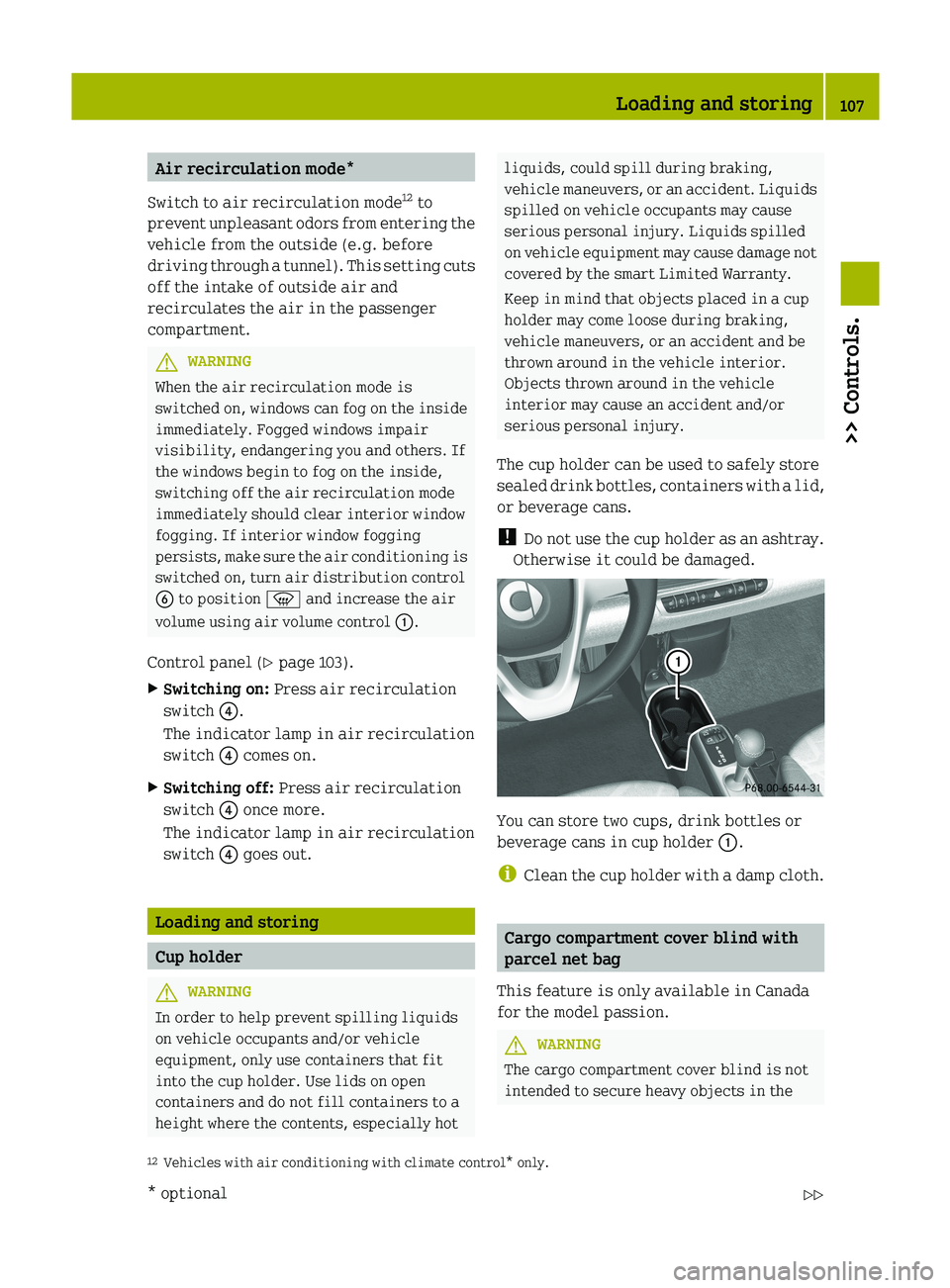
Air recirculation mode*
Switch to air recirculation mode 12
to
prevent
unpleasant odors from entering the
vehicle from the outside (e.g. before
driving through a tunnel). This setting cuts
off the intake of outside air and
recirculates the air in the passenger
compartment. G
WARNING
When the air recirculation mode is
switched
on, windows can fog on the inside
immediately. Fogged windows impair
visibility, endangering you and others. If
the windows begin to fog on the inside,
switching off the air recirculation mode
immediately should clear interior window
fogging. If interior window fogging
persists, make sure the air conditioning is
switched on, turn air distribution control
B to position z and increase the air
volume using air volume control :.
Control panel (Y page 103).
X Switching on: Press air recirculation
switch ?.
The indicator lamp in air recirculation
switch ? comes on.
X Switching off: Press air recirculation
switch ? once more.
The indicator lamp in air recirculation
switch ? goes out. Loading and storing
Cup holder
G
WARNING
In order to help prevent spilling liquids
on vehicle occupants and/or vehicle
equipment, only use containers that fit
into the cup holder. Use lids on open
containers and do not fill containers to a
height where the contents, especially hot liquids, could spill during braking,
vehicle
maneuvers, or an accident. Liquids
spilled on vehicle occupants may cause
serious personal injury. Liquids spilled
on vehicle equipment may cause damage not
covered by the smart Limited Warranty.
Keep in mind that objects placed in a cup
holder may come loose during braking,
vehicle maneuvers, or an accident and be
thrown around in the vehicle interior.
Objects thrown around in the vehicle
interior may cause an accident and/or
serious personal injury.
The cup holder can be used to safely store
sealed drink bottles, containers with a lid,
or beverage cans.
! Do not use the cup holder as an ashtray.
Otherwise it could be damaged. You can store two cups, drink bottles or
beverage cans in cup holder :.
i
Clean
the cup holder with a damp cloth. Cargo compartment cover blind with
parcel net bag
This feature is only available in Canada
for the model passion. G
WARNING
The cargo compartment cover blind is not
intended to secure heavy objects in the
12 Vehicles with air conditioning with climate control* only. Loading and storing
107
>> Controls.
* optional Z
Page 110 of 228
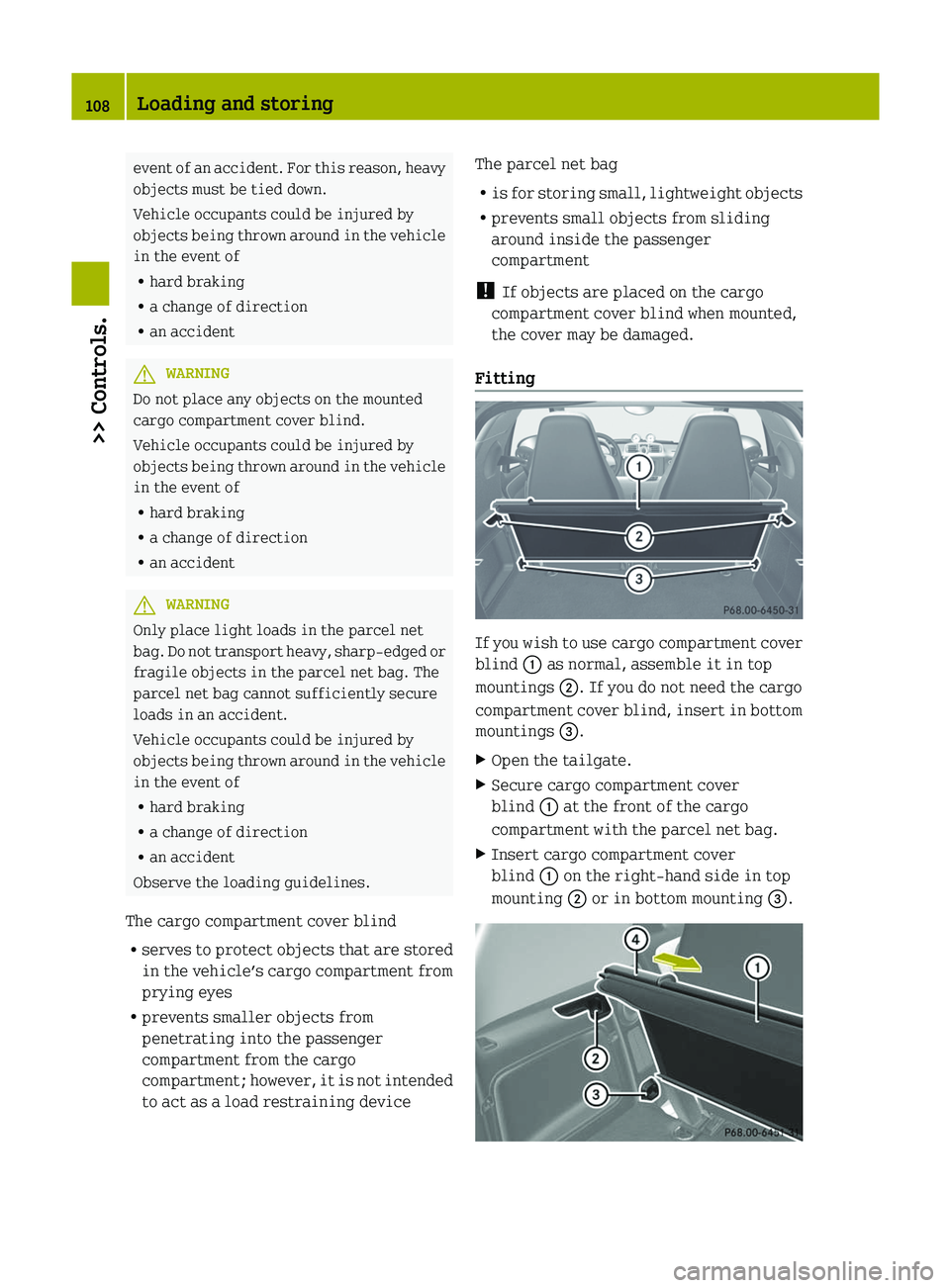
event of an accident. For this reason, heavy
objects must be tied down.
Vehicle occupants could be injured by
objects
being thrown around in the vehicle
in the event of
R hard braking
R a change of direction
R an accident G
WARNING
Do not place any objects on the mounted
cargo compartment cover blind.
Vehicle occupants could be injured by
objects
being thrown around in the vehicle
in the event of
R hard braking
R a change of direction
R an accident G
WARNING
Only place light loads in the parcel net
bag.
Do not transport heavy, sharp-edged or
fragile objects in the parcel net bag. The
parcel net bag cannot sufficiently secure
loads in an accident.
Vehicle occupants could be injured by
objects being thrown around in the vehicle
in the event of
R hard braking
R a change of direction
R an accident
Observe the loading guidelines.
The cargo compartment cover blind
R serves to protect objects that are stored
in the vehicle’s cargo compartment from
prying eyes
R prevents smaller objects from
penetrating into the passenger
compartment from the cargo
compartment; however, it is not intended
to act as a load restraining device The parcel net bag
R
is
for storing small, lightweight objects
R prevents small objects from sliding
around inside the passenger
compartment
! If objects are placed on the cargo
compartment cover blind when mounted,
the cover may be damaged.
Fitting If you wish to use cargo compartment cover
blind : as normal, assemble it in top
mountings ;. If you do not need the cargo
compartment
cover blind, insert in bottom
mountings =.
X Open the tailgate.
X Secure cargo compartment cover
blind : at the front of the cargo
compartment with the parcel net bag.
X Insert cargo compartment cover
blind : on the right-hand side in top
mounting ; or in bottom mounting =.108
Loading and storing
>> Controls.